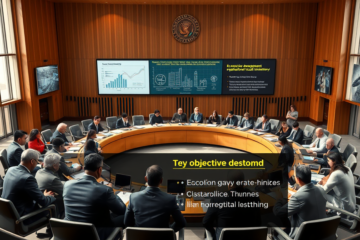Unemployment in Brazil Reaches 5.6% with 102.4 Million
Unemployment in Brazil is a topic that has generated in-depth discussions and analyses in recent years.
With the recent drop in the unemployment rate to 5.6% in the quarter ending July 2025, it is essential to understand the factors that contributed to this reduction, in addition to assessing the impact on the labor market and the country's economy.
The growth in the number of employed people, the sectors that stood out the most and the reduction in informality are aspects that deserve attention.
This article will address these points and the current employment scenario in Brazil.
Labor Market Outlook for July 2025
The panorama of the Brazilian labor market in the quarter ending in July 2025 presents impressive and extremely positive numbers.
A unemployment rate of 5.6%, the lowest since 2013, indicates a significant recovery in the national employment scenario.
With the record 102.4 million employees, the relevant contribution of the public sector and education in the creation of stable and quality jobs stands out.
Furthermore, the reduction of informality deserves attention, with the rate falling to 37.8%, which represents an important advance in the formalization of the labor market.
According to the Sebrae, the generation of jobs in Micro and Small Businesses has also been a positive factor in this scenario.
Average monthly earnings reached R$ 3,484, while the real income mass rose to R$ 352.3 billion.
These figures highlight not only the creation of jobs, but also the increase in the quality of these jobs.
Looking to the near future, projections indicate that the unemployment rate could stabilize at around 5.5% by the end of 2025, maintaining the trajectory of growth and positive employability.
Fall in Unemployment and Informality
The unemployment rate in Brazil fell to 5,6% in the quarter ending in July, which represents the lowest value since 2013, as reported by IBGE.
Along with unemployment, informality also declined, registering 37,8%, highlighting the decrease in activities without a formal contract.
Recent economic measures, combined with investment in sectors such as the public sector and education, were crucial to these results.
While the public sector provides stability, investment in education trains more professionals for the formal market.
- 5.6% – Lowest unemployment rate since 2013
- 37.8% – Significant drop in informality
- 102.4 million – Total employed reaching a new level
This promising scenario is directly reflected in the increase in average monthly income for R$ 3.484, effectively improving the population's quality of life.
Reducing unemployment not only reduces the discouragement rate, which fell 11% in the last quarter, but also promotes a more equitable redistribution of income.
This translates into greater economic security, less job insecurity, and an optimistic outlook for the future of employment in Brazil by the end of 2025.
Average Income and Wage Bill
Brazil reached a significant milestone in the economic landscape in 2025, with the average monthly income reaching R$ 3.484 according to IBGE data.
This reflects notable growth throughout the year, boosting workers' purchasing power and generating positive effects on the economy.
The total wage bill R$ 352.3 billion, reaffirming the strength of the job market.
Thus, the significant reduction in unemployment and the increase in wages bring direct benefits to millions of Brazilians, positively influencing several economic sectors, especially domestic consumption.
“The increase in wages reinforces domestic consumption”, experts point out, referring to the impact on retail sales.
Education and the public sector are key players in this evolution, indicating a promising trend for the country's continued economic and social development, while the informality rate declines.
Outlook until the end of 2025
By the end of 2025, forecasts for the labor market indicate continued improvement in its main indices.
With the drop in the unemployment rate, which is approaching 5,5%, Brazil is moving forward on the path to economic recovery.
The reduction of underutilization from work to 14,1% reflects a positive adjustment in the effective utilization of the workforce, contributing to more robust economic growth.
At the same time, there is a significant decrease in discouragement, with a reduction of 11%, which demonstrates an increase in Brazilian workers’ confidence in the job market.
- Unemployment rate close to 5,5%
- Fall of underutilization to 14,1%
- Reduction of discouragement in 11%
These advances highlight a favorable scenario, fostering an environment of optimism and expectations of sustainable growth.
With continuous improvements, Brazil is positioning itself positively in the global economic scenario, fostering new opportunities and development.
In summary, progress in the Brazilian labor market is evident, with the unemployment rate at its lowest level since 2013 and positive expectations for the coming years. This is a time of hope and opportunity for the country's economic development.



0 Comments